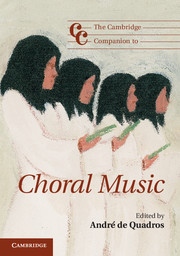Book contents
- Frontmatter
- 1 Introduction: choral music – a dynamic global genre
- Part I Choral music: history and context
- 2 A brief anatomy of choirs c.1470–1770
- 3 Choral music in the culture of the nineteenth century
- 4 Choral music in the twentieth and early twenty-first centuries
- 5 The nature of chorus
- Part II Choral music the world over
- Part III Choral philosophy, practice, and pedagogy
- Notes
- Select bibliography
- Index
- Cambridge Companions to Music
5 - The nature of chorus
from Part I - Choral music: history and context
Published online by Cambridge University Press: 28 September 2012
- Frontmatter
- 1 Introduction: choral music – a dynamic global genre
- Part I Choral music: history and context
- 2 A brief anatomy of choirs c.1470–1770
- 3 Choral music in the culture of the nineteenth century
- 4 Choral music in the twentieth and early twenty-first centuries
- 5 The nature of chorus
- Part II Choral music the world over
- Part III Choral philosophy, practice, and pedagogy
- Notes
- Select bibliography
- Index
- Cambridge Companions to Music
Summary
The English language has two perfectly good words to describe a body of singers: chorus and choir. They mean almost the same thing and are often used interchangeably, and yet there is a difference between them. Both words derive ultimately from the same source – the Greek χορός – but they entered the English language at different times and for very different reasons.
Choir is derived from the Old French cuer. According to the Oxford English Dictionary, the earliest English references to the word date from the fourteenth century. Choir refers originally to the place in the church where the service is sung and by extension to those who sing it. Chorus came into use during the sixteenth century directly from the Greek, along with many other new words ushered in by the Humanist revival of Greek culture. Its primary meaning is a group of dancers and singers. There is also the closely related meaning (which I will return to later) of the refrain or burden of a song, where those who have been listening join in.
Choir is therefore the thing – the group of people who sing together, and the particular part of a church where they do this. Chorus can also refer to a group (though not to a place), but it leads us towards the issue of what the function of a body of singers might be, in both a musical and a dramaturgical sense. In church it is the choir we notice processing in at the beginning of a service – we don’t usually call them a chorus. In classical Greek drama it is the chorus that makes an entrance – we don’t call them a choir even though, originally, they sang; if we speak of a Greek choir then we are identifying a group of singers by their nationality. In a concert situation these distinctions start to blur. We probably refer to the choir coming on stage – even if it’s called the LSO Chorus – while those sections of music sung by the choir are called choruses, as in “The choir sang a chorus from Handel’s Messiah.” Mercifully, the two words are reunited in the phrase choral music.
- Type
- Chapter
- Information
- The Cambridge Companion to Choral Music , pp. 61 - 76Publisher: Cambridge University PressPrint publication year: 2012



